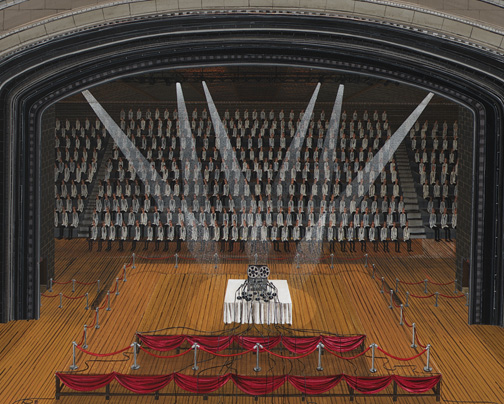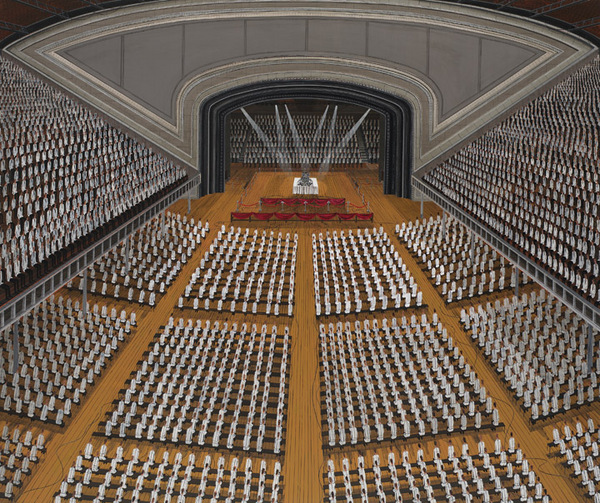This is an archive of the ArtCat Zine, 2007-2009. Please visit our new project, IDIOM.
On "Climate"
Editor's note: Climate is currently hanging as part of Utopia/Dsytopia on view at the Leslie Tonkonow gallery through Friday 29 August 2008.
There are two different types of hell in literature and art. The first is that fire and brimstone landscape of Hieronymus Bosch and Dante with all its bloody gothic excess. The second is the hell of Baselitz and Sartre's No Exit. It’s a Twilight Zone of subtler and more ironic punishment that reveals more about human nature. An enigmatic painting by Ian Davis currently on view at the Leslie Tonkonow Gallery falls into this second category. Climate depicts an auditorium of men dressed uniformly with their attention fixed upon an old-fashioned reel-to-reel audio player. A dystopian level of conformity and obedience dominates the space.
Davis's lines achieve a convincing illusion of recession and a coherent architectural framework. The work began as a grid and the artist carefully delineated these different planes of color. The recessed stage and expansive architecture reaching out beyond the picture's edges cast the crowd as massive and almost infinite.
The ambiguous facial expressions are unfortunately not apparent in online reproductions. Gazing closely at the painting, one observes faces that are rich in expressive details but vague on precise emotion. These unclear facial expressions are more arresting because they speak of that human need to reach closure and resolution. It’s an uncommon image in a visual culture of emoticons where faces express clear sentiments and convey thumbs-up or thumbs-down to the recipient. The white uniforms meanwhile, with their subtly differing shadows and highlights, create a sensuous surface pattern across the picture plane. Their uniformity dominates the picture visually and symbolically. A herd of docile white sheep assembles into an imposing group.
The artist confessed to your commentator that he worked on this picture for a long period of time without knowing what precisely he would place as the focal point of the stage. His choice of the reel to reel audio player is provocatively cryptic. The work is silent, so the content of the emitted sound is a mystery. The device could just as well be making no noise at all.
In a dialogue with Leslie Tonkonow, Davis explained why he waited until the end to select the focal point of a similar picture, “I spent weeks constructing the room and the clumps of figures but I had no idea what was going to happen on the stage or what the painting was ultimately about. Eventually I realized that the subject was the situation in which the huge crowd stares and waits.” Much like the crowd’s faces, the work’s meaning derives it potency from an irresolvable ambiguity surrounding the situation.

The work’s title Climate is a more discrete marker of meaning: the picture of course might be framed as a commentary on climate change. Is it news of a natural environment in disrepair about which we can hear and worry, but not see? It could also be framed as a commentary on the political climate. Do we allow the media to brainwash us into the obedience of conformity? Part of the strength of this picture is its ability to accommodate such varied interpretations. Like an engaging riddle, it’s satisfyingly difficult to unravel and solve. You keep looking at it convinced that you will eventually unlock the picture's meaning.
At the end of his life, Freud became very interested in the impact of group psychology. This final turn is less popularly known because his earlier phase jives better with today’s preoccupations with the driving force of personal experiences. Freud saw an underlying and hardwired tendency for humans to invest in group identity. Although he observed that we ostensibly discard this desire when we take on ambitious or aggressive alpha roles, he still believed that we remained forever susceptible to the group's appeal.
Ian Davis’s current body of work reflects these late interests of Freud. There is a high thrill and a deep danger in turning your identity over the crowd. By thickly covering this work with ambiguity, the piece captures how the jury is still out deliberating this tradeoff.
ZINE
HOME
TIPS / COMMENTS
CATEGORIES
CONTRIBUTORS
- Greg Afinogenov
- B. Blagojevic
- Adda Birnir
- Susannah Edelbaum
- Julie Fishkin
- Paddy Johnson
- Jessica Loudis
- Christopher Reiger
- Andrew Robinson
- Peter J. Russo
- Blythe Sheldon
- S.C.Squibb
- Hrag Vartanian

